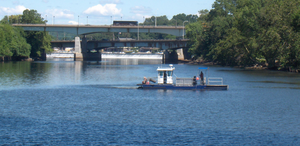|
Spring Garden Street Bridge
Spring Garden Street Bridge is a highway bridge in Philadelphia, Pennsylvania. It crosses the Schuylkill River below Fairmount Dam and connects West Philadelphia to the Philadelphia Museum of Art and Benjamin Franklin Parkway. It is the fourth bridge at this location. The bridge is located at 39°57′52″N 75°11′00″W / 39.96444°N 75.18333°W. 1st bridge: The Colossus As early as 1693, a ferry operated, crossing the Schuylkill River at Fairmount, the hill on which the Philadelphia Museum of Art now stands.[1] Being upstream of the others, this was called the Upper Ferry. For the Upper Ferry site, bridgebuilder Louis Wernwag designed "The Colossus", the longest single-span wooden bridge in the United States. Construction began in April 1812, and it opened on January 7, 1813. A double-arched-truss with a clear span of 340 feet (103.6 m), it was a marvel of engineering for its time. Also called the "Colossus of Fairmount," the "Upper Ferry Bridge," and the "Lancaster Schuylkill Bridge," the toll bridge was part of the Philadelphia and Lancaster Turnpike. It was destroyed by fire on September 1, 1838.[2] Thomas Birch painted at least two views of the bridge, and one of them was made into an 1813 engraving by Jacob J. Plocher. This "Upper Ferry Bridge" engraving was copied frequently on Staffordshire china.[3]
2nd bridge: Wire Bridge at Fairmount Five miles upstream from Fairmount, iron manufacturers Josiah White and Erksine Hazard built a wire-cable footbridge in 1816. Though a modest structure – 407 feet (124 m) in length with a suspended walkway 18 inches (0.46 m) wide – and a temporary one – it stood for less than a year – the Spider Bridge at Falls of Schuylkill is thought to have been the first wire-cable suspension bridge in history.[4] Twenty-five years later, permanent wire-cable suspension bridges had been built in France and Switzerland. To replace "The Colossus," Charles Ellet, Jr. designed the first major wire-cable suspension bridge in the United States.[5] The 358-foot-long (109 m) "Wire Bridge at Fairmount" was commissioned by the City of Philadelphia, and opened to traffic on January 2, 1842. It had no toll, and stood for over thirty years.[6] Ellet would go on to design the 1,010-foot (310 m) Wheeling Suspension Bridge (1847–49); and the first Niagara Falls Suspension Bridge (1847–48), which was abandoned before completion.
3rd bridge: Callowhill Street Bridge The Callowhill Street Bridge was designed by Jacob H. Linville, engineer, and built by the Keystone Bridge Company, 1874–75. A double-decker bridge that carried passengers, vehicles and streetcars on its upper deck and trains (later removed) on its lower, it was a Whipple truss of cast and wrought iron, 350 feet (110 m) long and 48 feet (15 m) wide. The arches between the decks were decorative and removed circa 1900; the ornate railings were removed by 1910. It was demolished in 1964.[7]
4th bridge: Spring Garden Street Bridge The current bridge was designed by Richard Wisniewski of Philadelphia, and completed in 1965. It carries West Spring Garden Street over the Pennsylvania Railroad lines, the Schuylkill Expressway, the Schuylkill River, and the Schuylkill River Trail. The West River Drive Bridge crosses diagonally beneath it, carrying the Dr. Martin Luther King, Jr., Drive over the Schuylkill River.
See also
Notes
References
External linksWikimedia Commons has media related to Spring Garden Street Bridge.
|
||||||||||||||||||||














